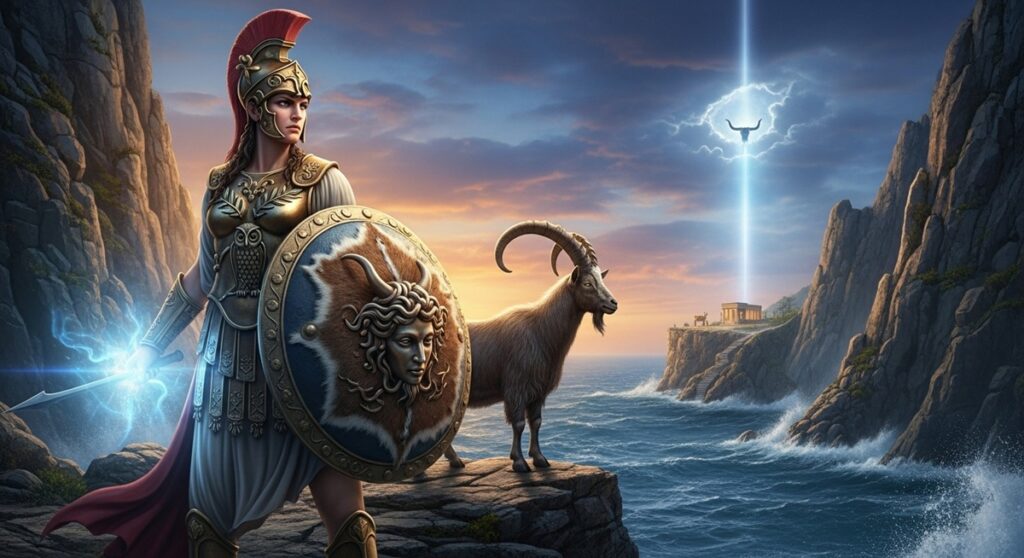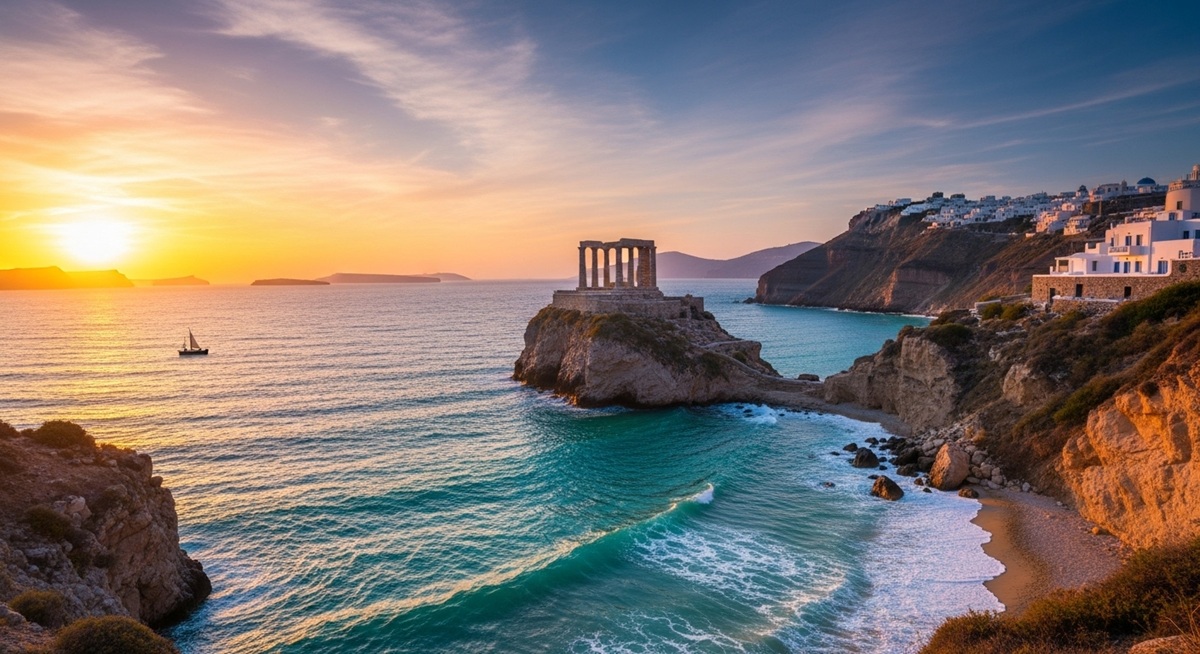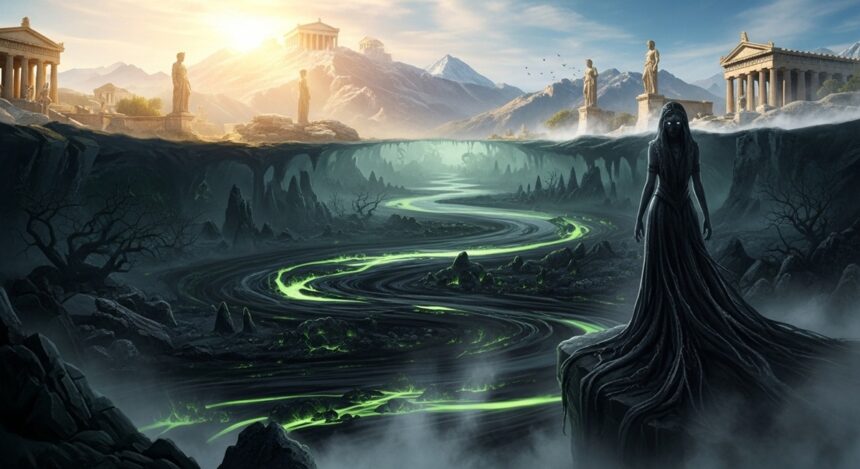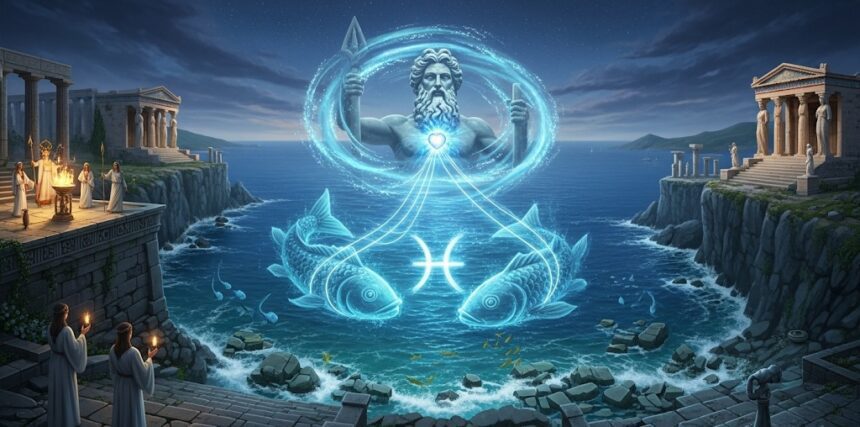The Aegean Sea has long captivated the human imagination, serving as a cradle of ancient civilizations, a battleground for gods and heroes, and a natural wonder shaped by millions of years of geological drama. Stretching between Greece and Turkey, dotted with iconic islands like Crete, Santorini, and Mykonos, this body of water is a geographical feature shaped by ancient footsteps, legends, scientific history, and linguistic mysteries. But where did the name “Aegean Sea” truly come from? Is it rooted in the tragic tale of a heartbroken king, the uneven landscapes of prehistoric lands, or something as whimsical as a goat leaping across rocky cliffs?
The Tragic Myth of Aegeus and Theseus: A Father’s Despair
At the heart of the Aegean Sea‘s nomenclature lies a poignant Greek myth involving Aegeus, the legendary king of Athens, and his son Theseus. This story, passed down through generations via ancient texts like those of Plutarch and Ovid, encapsulates the themes of heroism, forgetfulness, and irreversible tragedy that define much of Greek lore.
Theseus, the heroic prince, set sail for Crete to confront the fearsome Minotaur—a half-man, half-bull monster lurking in the infamous Labyrinth designed by Daedalus. Before departing, Theseus promised his father a signal of victory: if he slayed the beast, he would replace the ship’s black sails—symbolizing mourning—with white ones on the return voyage. Aegeus, anxious and watchful, stationed himself at Cape Sounion, a dramatic promontory south of Athens overlooking the sea.
The plan seemed foolproof, but fate intervened. Theseus did indeed vanquish the Minotaur, rescuing Athens from the annual tribute of young men and women sent to Crete as sacrifices. In the euphoria of triumph and perhaps distracted by his newfound love for Ariadne, he forgot to change the sails. As the ship approached, Aegeus spotted the black cloth billowing in the wind. Overwhelmed by grief, convinced his son had perished, he hurled himself from the cliffs into the churning waters below.

From that fateful plunge, the sea earned its name: the Aegean Sea, forever memorializing Aegeus‘ sorrow. Even today, visitors to Cape Sounion can gaze upon the Temple of Poseidon, perched on those same rocks, and imagine the king’s despair echoing across the waves. This myth isn’t just a tale of paternal love gone awry; it underscores the ancient Greeks’ penchant for naming natural features after human dramas, turning geography into a repository of stories.
But is this the definitive origin? Scholars debate its authenticity, noting that while the legend is compelling, it might be a later rationalization. Ancient sources like Herodotus mention the sea by name without tying it explicitly to Aegeus, suggesting alternative explanations. This leads us to explore deeper, into the earth’s own turbulent history.
Geological Turbulence: The Birth of the Aegean from Ancient Lands
Beyond myths, the Aegean Sea‘s formation is a saga written in stone, volcanoes, and seismic shifts—a geological epic spanning millions of years. The name itself may derive from “Aegis,” an ancient landmass that once occupied the region now submerged under these waters. This is backed by paleogeographic evidence that paints a picture of a dramatically different Mediterranean.
During the early Miocene epoch, around 23 million years ago, tectonic forces began reshaping the area. The African plate’s northward push against the Eurasian plate caused uplift, birthing a vast, continuous land called Aegis. This proto-continent connected what are now Greece, Turkey, and the Balkans, with no sea in between. Imagine a landscape of rolling hills, rivers, and perhaps early hominids roaming where ferries now ply between islands.
As the Miocene gave way to the Pliocene—roughly 5.3 to 2.6 million years ago—Aegis started fracturing. Subsidence created basins that filled with water, forming lakes and inland seas. Volcanic activity intensified, with eruptions spewing ash and lava, altering the terrain. The Pleistocene period, from about 2.6 million to 11,700 years ago, delivered the final blows: ice ages fluctuated sea levels, and ongoing tectonics deepened rifts, flooding valleys and isolating landmasses into the archipelago we know today.

A standout event in this geological narrative is the cataclysmic eruption of Santorini (ancient Thera) around 1600 BCE. This Minoan eruption, one of the largest in human history, devastated Crete’s Minoan civilization and reshaped the caldera. It spewed enough ash to bury Pompeii-like settlements on the island, and its tsunamis may have inspired Plato’s Atlantis myth. Such volcanic drama didn’t just sculpt the Aegean Sea; it influenced its mythology, with gods like Poseidon—earth-shaker and sea-lord—embodying these forces.
Precipitation patterns, seismic events, and erosion continued to refine the region until relatively recent times. By the end of the Pleistocene, the Aegean Sea had assumed its modern form: a semi-enclosed basin with over 2,000 islands, trenches as deep as 5,000 meters, and a coastline riddled with bays. This geological volatility explains the sea’s “terrible” reputation, as noted by ancient lexicographer Suidas—narrow passages between islands amplify winds and currents, creating treacherous conditions for sailors.
While the name “Aegean” postdates these changes, its prehistoric roots are undisputed. Linguists trace it to Indo-European origins, but the most fascinating link? The word “aiga,” meaning goat. This seemingly odd connection bridges geology with mythology and everyday observation.
Etymological Mysteries: Why “Goat” Defines the Aegean
The name “Aegean” derives from the ancient Greek “Aigaíos,” rooted in “aix” or “aiga”—the word for goat. But why associate a sea with a cloven-hoofed animal? Explanations vary, each delving into prehistory, sacred symbolism, and poetic metaphors, revealing how ancient peoples perceived their world.
The Sacred Goat in Ancient Myths and Worship
One compelling theory ties the Aegean Sea to the goat‘s role in Minoan and Greek mythology. In Crete, the cradle of Europe’s oldest civilization, the goat was revered as a sacred animal. Consider the myth of Zeus’ infancy: pursued by his father Cronus (Saturn in Roman lore), the young god was hidden in Crete’s Dikteon Cave and nursed by Amalthea, a divine goat. Her milk sustained him, and upon her death, Zeus fashioned her hide into the “aegis”—a protective shield later wielded by Athena.
This “aegis” (from “aix”) became a symbol of divine power. Zeus earned the epithet “Aigiochos” (goat-bearer), and Athena’s shield, wrapped in goat skin, represented invincibility. In Minoan art, such as the rhyton from Kato Zakros, goats crown peak sanctuaries alongside sacred horns, emphasizing their holiness.

Coastal sanctuaries dedicated to Poseidon, often called “Aigos” (goat-related), dotted the Aegean shores. These sites, honoring the sea god, may have lent their name to the surrounding waters. Even today, Cretans refer to goats by their ancient name, preserving this linguistic thread. The goat‘s sacredness—unruly, resilient, and tied to fertility—mirrors the sea’s untamed spirit.
Waves as Goats: The Undulating Sea’s Poetic Name
Another interpretation is more observational: ancient Greeks called large waves “goats” due to their white, frothy crests resembling a goat‘s beard or wool. On stormy days, the Aegean Sea‘s surface erupts in “goats” or “sheep”—caps of foam leaping like a herd across hills. This metaphor fits the sea’s character: the Aegean is notoriously wavy, with winds funneled through island gaps creating swells that mimic a goat‘s bounding gait.
The root word “aisso”—meaning to leap, surge, or move with momentum—underpins this. A goat “aissos” over rocks; waves “aissos” in tempests. Suidas described the Aegean Sea as “the most terrible,” alluding to its rushing currents and sudden squalls. Sailors navigating from Athens to the Cyclades know this well—the Meltemi winds can turn a calm voyage into a chaotic dance of whitecaps.

This etymology isn’t isolated; similar naming occurs in other cultures, where natural phenomena draw from animal behaviors. In the Aegean, it blends utility with poetry, turning a practical observation into a lasting legacy.
A Blend of Past and Present
The Aegean Sea embodies a confluence of human emotion, earthly upheaval, and linguistic creativity. From Aegeus‘ leap to the fracturing of Aegis, from Amalthea‘s nurture to waves capering like goats, its name encapsulates millennia of change. Today, it draws millions for its beaches, ruins, and sunsets, but beneath the surface lies a deeper narrative.
Volcanic echoes in Santorini‘s cliffs, Minoan frescoes depicting marine life, and ongoing seismic activity remind us of its dynamic nature. As climate change raises sea levels and alters currents, the Aegean‘s story continues evolving. Yet, its myths endure, inviting us to ponder: is the sea named for a king’s sorrow, a lost land, or a leaping goat? Perhaps all three, intertwined like the threads of Ariadne’s string.
In traversing these waters—whether by ferry or imagination—we connect with ancestors who saw divinity in every swell. The Aegean Sea isn’t just a name; it’s a portal to antiquity, urging us to respect its power and cherish its beauty.






















